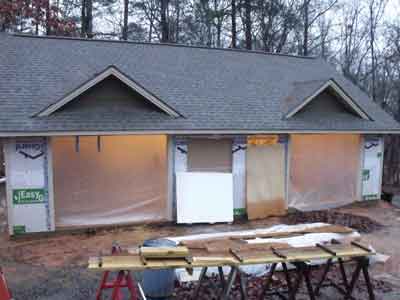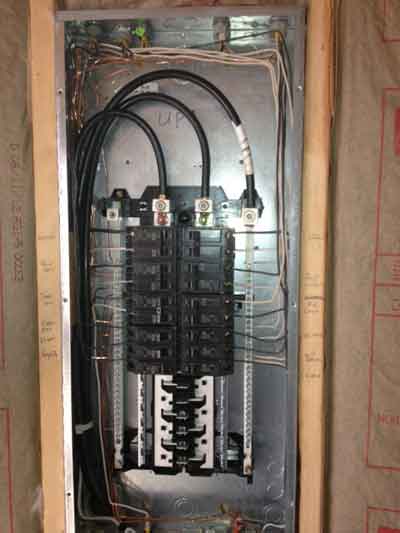My Last Shop: Part 7 - Construction Details
by Michael Smith
Mountain Park, GA
Click on any picture to see a larger version.
Hello again, this is my seventh installment of my experience with building my last shop. To bring you up to speed I am a retired California high school woodshop teacher now living in Mountain Park, GA near my two grown children and their families. Not counting the woodshop where I taught this will be my fourth and last (probably) shop.
Randy and Justin have finished the framing and now I'm on my own. Well sort of. Now the work is what I call nidgey work. That is to say that it's detail work. Cut-and-fit, pull and attach, up the ladder and down again, detail, detail. You know what I mean. At the end of the day the wifie will come in and say, "Well, what did you do all day? Arrrrgh!
First, I get the house wrap on. Ladder work…of course. I have an old slap stapler and plenty of staples. Easy-peasy except for the ladder part. I had housewrap leftover from a previous job and I thought it would do the whole thing. There I go again, more on this later.
And the next thing is to get a roof on. I'm not going to do that. I'm too old and with an 8/12 pitch the roof is too steep. 13 squares of Architectural shingles is too much for me to haul up a ladder and they don't deliver to the roof here. I had found a roofer that worked with his crew so I had him come to do the work. I had all of the roofing materials here for them except the nails. In six hours they had the roof done. Geez! It would have taken me a week.

|
As you know when you build something like this you need to get a permit. Permits mean inspections at particular points in construction. It was time for a housewrap and roof inspection. This time I had a different inspector. I was thinking that he was going to give it a quick look and sign it off. There I go again. His first comment was, "I don't see enough button caps. What's holding the housewrap on?" I was baffled. I didn't know what he meant. The staples hold it on, don't they? Then the siding goes on and that holds it too, doesn't it? The inspector went on to say that different housewrap manufacturers have different requirements. One may recommend button caps every 12 inches, another requires every 18 inches and to top it off, the maker of the house wrap I used on the bottom forbids staples! I was flummoxed. OK Dude, you want button caps? I can do that. In retrospect, since it is not an inhabited living space, I don't think I was required to wrap the shop at all. What do you think?
Since then, I have spoken to several people in the trades that I would think know about housewrap and the Uniform Building Codes and no one had a clue about this. On a following inspection I had Inspector Rick and I asked him about housewrap codes. He responded, "Oh, you must have had Inspector Kenny for that inspection. Kenny has a thing for housewrap." "Well," I ask, "What is the code for housewrap?" Rick replied, "The code is not specific, this is a situation where the product is applied according to the manufacturers' instructions. If every manufacturer has a different instruction, that's how you apply it." Arrrrgh! Rick passed my housewrap so we are moving on.
I decided to do the rough electrical wiring myself. I've had enough experience myself to run circuits. The only thing I was unsure about was how to wire the outside meter box to the inside circuit breaker panel. So I did the rough wiring, nailing on boxes and pulling wires - this is pretty straightforward work - and then called an electrician.
Floyd came out to wire the two back-to-back panels I had mounted and sink the two required ground rods. The two things about electrical work I don't understand are how to size wires and how to know the difference between a neutral and a ground. Floyd knew what size wires to use from panel to panel. He knew to use 4 gauge bare copper for the ground wire between the rods and the meter panel. What he couldn't explain to me was why the neutral bar in the meter box outside had both the incoming neutral and the incoming ground attached to it but the circuit panel has a separate ground bar (screwed to the metal box) and a Neutral bar (screwed to the metal box) and the metal bridge between them that was installed by GE is removed. I don't know how else to explain this so I'll apologize to you now. If you know the answer to this, one of the great mysteries of life to me, I'd like to know. The long and short of this is that my ignorance on these issues cost me $400.00. Something I did not like.

|
Something else I didn't like is the requirement, by code, to use Tamper Resistant receptacles. These receptacles are required in all residential (not commercial) buildings. They consist of a plastic shield inside to prevent children from sticking things in and getting an electrical shock. On the surface, that's a good thing, but, for me, I have had to replace every one of my two prong plugs on my tools that I have been using for construction. For some reason it doesn't seem to affect the grounded 3 prong plugs. The real irony of this code is that if you build a daycare center (or a school) you aren't required to use Tamper Resistant receptacles. Those are commercial codes... go figure.
After the rough electrical work was approved I started on insulation. I know you are probably thinking that it's cheaper and to have insulation installed by others but hey, I have the time and the experience. I can do this.
I could hang the sheet rock and tape it, I've done it many times but again, it would take me a while and I'm just too damned old to put up with it. So I hired Ben and Richard to hang the rock and tape it off. Ben and Richard are a father/son team and a pleasure to have on the job - very good conversationalists.
Again, I bought the rock and joint compound and tape. All they had to bring were the screws. I thought I was buying the old standard retail 1/2 X 4 X 8 sheetrock. What was delivered and now standard was a lightweight (compared to the old stuff) sheetrock. Oh boy, that was a pleasant surprise. It would still be a task for one person to hang but much better.
Well that's enough for now I think. I'm getting to the home stretch now. Siding, windows, paint and a bunch of other details but I can see the light at the end of the tunnel. Send me an e-mail if you have a comment or question.
Michael can be reached by email at
woodsmith@sonic.net
.
Return to
Wood News
front page


